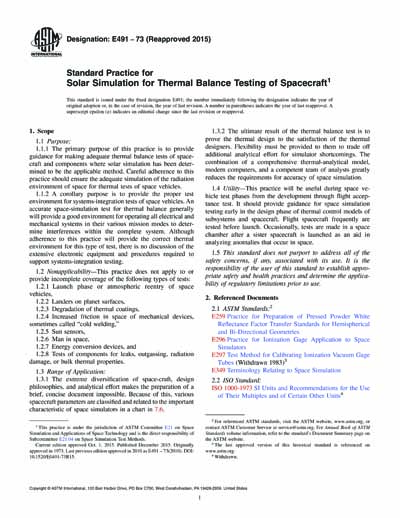Historical
ASTM E491-73(2015)
Standard Practice for Solar Simulation for Thermal Balance Testing of Spacecraft
1.1 Purpose:
1.1.1 The primary purpose of this practice is to provide guidance for making adequate thermal balance tests of spacecraft and components where solar simulation has been determined to be the applicable method. Careful adherence to this practice should ensure the adequate simulation of the radiation environment of space for thermal tests of space vehicles.1.1.2 A corollary purpose is to provide the proper test environment for systems-integration tests of space vehicles. An accurate space-simulation test for thermal balance generally will provide a good environment for operating all electrical and mechanical systems in their various mission modes to determine interferences within the complete system. Although adherence to this practice will provide the correct thermal environment for this type of test, there is no discussion of the extensive electronic equipment and procedures required to support systems-integration testing.1.2 Nonapplicability—This practice does not apply to or provide incomplete coverage of the following types of tests:...
1.3 Range of Application:
1.3.1 The extreme diversification of space-craft, design philosophies, and analytical effort makes the preparation of a brief, concise document impossible. Because of this, various spacecraft parameters are classified and related to the important characteristic of space simulators in a chart in 7.6.1.3.2 The ultimate result of the thermal balance test is to prove the thermal design to the satisfaction of the thermal designers. Flexibility must be provided to them to trade off additional analytical effort for simulator shortcomings. The combination of a comprehensive thermal-analytical model, modern computers, and a competent team of analysts greatly reduces the requirements for accuracy of space simulation.1.4 Utility—This practice will be useful during space vehicle test phases from the development through flight acceptance test. It should provide guidance for space simulation testing early in the design phase of thermal control models of subsystems and spacecraft. Flight spacecraft frequently are tested before launch. Occasionally, tests are made in a space chamber after a sister spacecraft is launched as an aid in analyzing anomalies that occur in space.
1.5 This standard does not purport to address all of the safety concerns, if any, associated with its use. It is the responsibility of the user of this standard to establish appropriate safety and health practices and determine the applicability of regulatory limitations prior to use.
Content Provider
ASTM International [astm]






